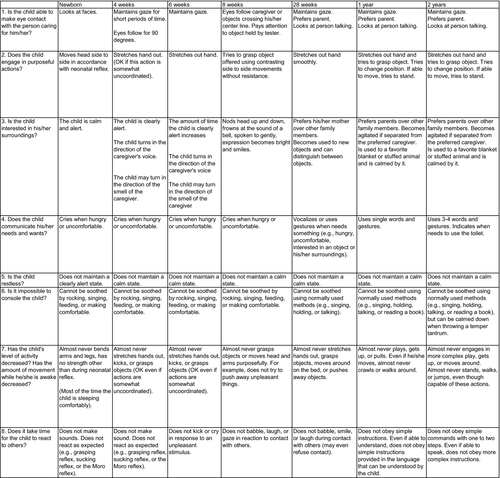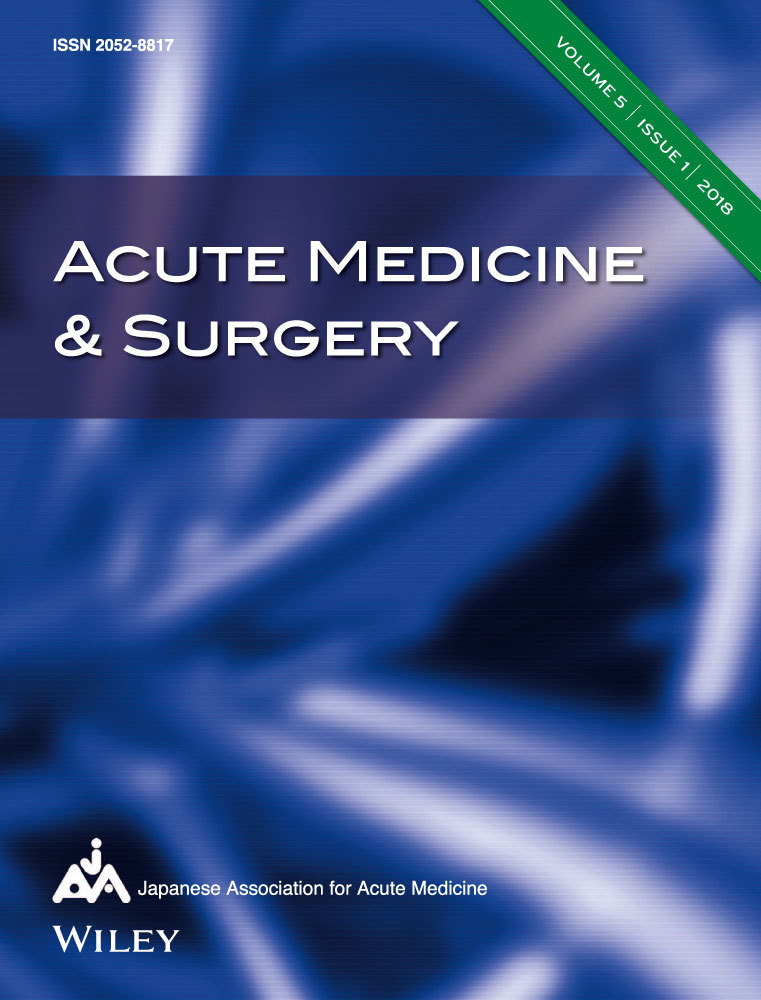Development of the Japanese version of the Cornell Assessment of Pediatric Delirium
Funding Information
No funding information provided.
Abstract
Aim
Delirium is a form of acute cerebral dysfunction and is associated with increased length of hospital stay, mortality, and health-care costs for adult patients in intensive care. However, in Japan, there are currently no reliable criteria or tools for diagnosing delirium in critically ill pediatric patients. The purpose of this study was to translate the Cornell Assessment of Pediatric Delirium (CAPD)—a screening tool for pediatric delirium—from English to Japanese for use in the diagnosis of delirium for pediatric patients in pediatric intensive care units.
Methods
The back-translation method was used to ensure equivalence in the Japanese version of the CAPD and its accompanying developmental anchor points. The translation process was repeated by a multidisciplinary committee of medical researchers and clinicians.
Results
The final back-translated version of the CAPD was submitted to the original author, who gave her approval.
Conclusion
The Japanese CAPD was developed and its effectiveness tested using a standardized procedure. Further study is required to test the validity and reliability of the Japanese version of the CAPD.
Introduction
Delirium is a form of acute cerebral dysfunction and is associated with systemic illness or the effects of treatment in an intensive care unit (ICU). Delirium involves acute and intermittent changes in mental status with disordered attention and cognition.1 Delirium has been shown to have negative clinical outcomes for in adult intensive care,2 such as increased length of hospital stay,3 mortality, and health-care costs.4 However, the implications of pediatric delirium in the Japanese context are not well clarified because of the lack of an adequate screening tool. Currently, there are a number of validated and reliable screening tools for delirium used in pediatric ICUs, including the Pediatric Anesthesia Emergence Delirium (PAED) scale,5 the Pediatric Confusion Assessment Method for the Intensive Care Unit (pCAM-ICU),6 and the Cornell Assessment of Pediatric Delirium (CAPD).7 The pCAM-ICU can be used only in children over 5 years old, and the PAED scale does not evaluate hypoactive delirium. In contrast, the CAPD is designed for children of all ages and can be used to assess hypoactive delirium. The CAPD is designed to give nurses a quick and easy way to screen for pediatric patients at risk of delirium.8 It consists of eight question items that correlate with the diagnostic domains of awareness and cognition. The nurse administering the CAPD answers each item on a 5-point Likert scale, the total score of which gives an indication of risk for delirium. However, the CAPD was not available in Japanese. The purpose of this study, therefore, was to create an accurate Japanese translation of the CAPD for use in clinical settings.
Method
Before beginning the translation of the CAPD, permission was obtained from its original author, Dr. Gabrielle Silver, who directed us to also translate the CAPD's accompanying developmental anchor points. The developmental anchor points were delineated for children under the age of 2 years, because orientation, arousal, and appropriate cognition (which are all affected in delirium) are difficult to assess in young children and even harder to measure in infants. In addition, the author advised us that the implication of item 8 (Does it take the child a long time to respond to interactions?) is that delayed or slow motion movement may be a sign of hypoactive delirium, and not only the lack of response.
To ensure linguistic and cultural equivalence in the Japanese translation of the CAPD and its accompanying developmental anchor points, the back-translation method was used. Back-translation, originally established by Brislin,9 is a well-known translation method used to ensure the preservation of the overall content and meaning between the original and translated versions. Specifically, the adaption of Brislin's translation model by Jones et al.10 was selected for this project as this method involves multiple people in the translation process.
The translation process followed a series of steps. First, the main researcher forward-translated the assessment tool from English to Japanese to create the provisional Japanese version. Next, the provisional Japanese version was given to a professional translator, a native Japanese speaker, who had also been a nurse in America, but was not familiar with the CAPD. The translator back-translated the provisional Japanese version into English to create the provisional English version. In the third step, a committee of eight medical professionals (two clinical researchers, two intensive care medical doctors, two pediatric doctors, and two pediatric intensive care nurses) discussed the differences of the original English version and the provisional English version to reduce variability through the expertise of a multidisciplinary medical team. Next, based on the findings of this discussion, the Japanese version was revised to create the final Japanese version. The final Japanese version of CAPD was once again back-translated to English by a professional translator. The final back translation was then checked by the original author. Every effort was made to carefully execute all the steps in the translation processes to avoid the loss of the original meaning due to cultural or linguistic differences.
This study was approved by the ethics board of University of Tsukuba Hospital (Tsukuba, Japan).
Results
The completed Japanese version of the CAPD and its accompanying developmental anchor points are presented in the supporting information (Data S1 and S2). There were a number of linguistic and semantic issues that arose through the translation process. The first was the item “Moves head to side, dominated by primitive reflexes” from the developmental anchor points. It is not common in Japan to assess the reflexes of newborns. We confirmed with the original author that this item was not referring to rooting reflexes and asymmetrical tonic neck reflex. As it was not, we translated the item word-for-word. In the provisional Japanese version, in the sentence “Does the child communicate need and want?,” the words “need and want” were translated using a single word in Japanese that includes both concepts. However, after careful discussion of this sentence in our committee, we decided to express them separately as in the original version.
The final English version of the CAPD and accompanying developmental anchor points were submitted to the author (Fig. 1 shows the final English version of the developmental anchor points). The original author approved the back-translated final English versions of the CAPD and developmental anchor points.

Discussion
We created the Japanese version of the CAPD and developmental anchor points using the back-translation method to avoid loss of its original meaning and author's intentions. We selected the back-translation method suggested by Jones et al.10 as it involves multiple people in the translation. We included a committee of eight medical professionals in the process of translation whose collective expertise allowed us to develop the final Japanese version of the CAPD, ensuring its accuracy, cultural appropriateness, and also faithfulness to the original intention of the author. Further study is required to evaluate the validity and reliability of the Japanese version of the CAPD and developmental anchor points.
Conclusion
Using the back-translation method, we successfully developed the Japanese version of the CAPD and its developmental anchor points, and the translated instruments were approved by the original author of the CAPD. It is hoped that, in the near future, the Japanese version of the CAPD will be an effective tool for identifying risk of delirium in Japanese pediatric patients.
Acknowledgments
The authors are grateful to Dr. Gabrielle Silver for granting us permission to translate the CAPD and providing invaluable guidance. We also thank Dr. Sumitani Masahiko for lending his expertise on delirium. Finally, we give heartfelt thanks to Mr. Thomas D. Mayers who provided language support.
Disclosure
This study was approved by the ethics board of University of Tsukuba Hospital (approval no. H28-085).
Conflict of Interest: The authors have no conflict of interest to declare.




